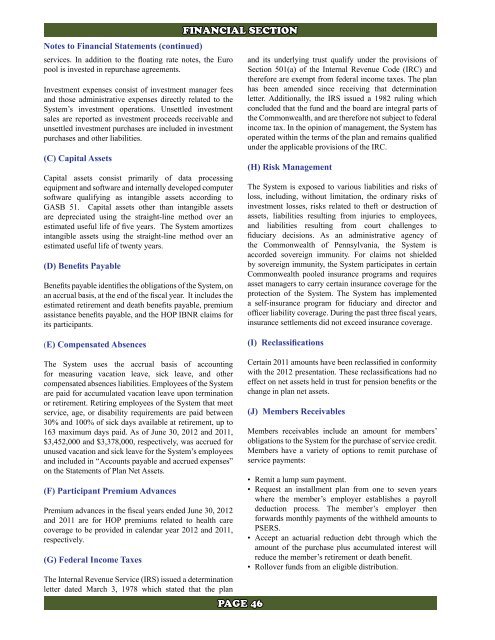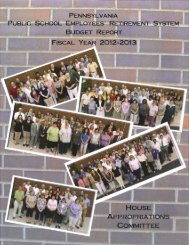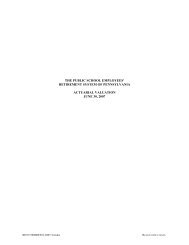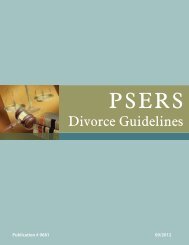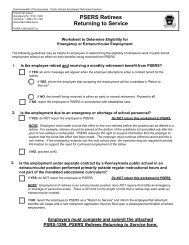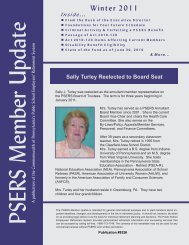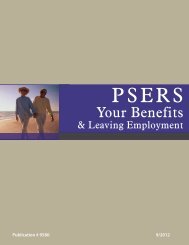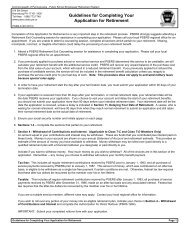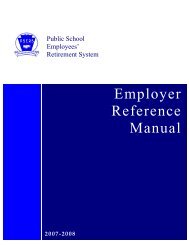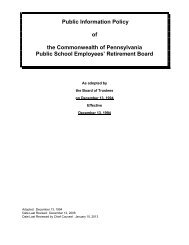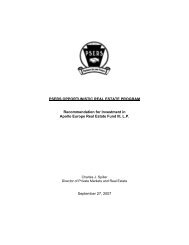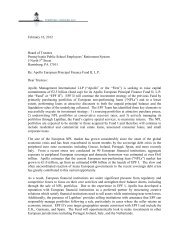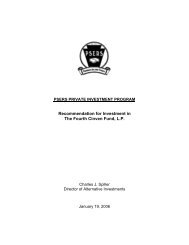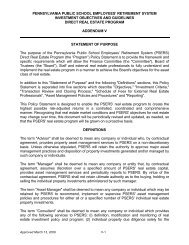a complete copy of the 2012 CAFR Report! - PSERs
a complete copy of the 2012 CAFR Report! - PSERs
a complete copy of the 2012 CAFR Report! - PSERs
Create successful ePaper yourself
Turn your PDF publications into a flip-book with our unique Google optimized e-Paper software.
Notes to Financial Statements (continued)<br />
services. In addition to <strong>the</strong> floating rate notes, <strong>the</strong> Euro<br />
pool is invested in repurchase agreements.<br />
Investment expenses consist <strong>of</strong> investment manager fees<br />
and those administrative expenses directly related to <strong>the</strong><br />
System’s investment operations. Unsettled investment<br />
sales are reported as investment proceeds receivable and<br />
unsettled investment purchases are included in investment<br />
purchases and o<strong>the</strong>r liabilities.<br />
(C) Capital Assets<br />
Capital assets consist primarily <strong>of</strong> data processing<br />
equipment and s<strong>of</strong>tware and internally developed computer<br />
s<strong>of</strong>tware qualifying as intangible assets according to<br />
GASB 51. Capital assets o<strong>the</strong>r than intangible assets<br />
are depreciated using <strong>the</strong> straight-line method over an<br />
estimated useful life <strong>of</strong> five years. The System amortizes<br />
intangible assets using <strong>the</strong> straight-line method over an<br />
estimated useful life <strong>of</strong> twenty years.<br />
(D) Benefits Payable<br />
Benefits payable identifies <strong>the</strong> obligations <strong>of</strong> <strong>the</strong> System, on<br />
an accrual basis, at <strong>the</strong> end <strong>of</strong> <strong>the</strong> fiscal year. It includes <strong>the</strong><br />
estimated retirement and death benefits payable, premium<br />
assistance benefits payable, and <strong>the</strong> HOP IBNR claims for<br />
its participants.<br />
FINANCIAL SECTION<br />
and its underlying trust qualify under <strong>the</strong> provisions <strong>of</strong><br />
Section 501(a) <strong>of</strong> <strong>the</strong> Internal Revenue Code (IRC) and<br />
<strong>the</strong>refore are exempt from federal income taxes. The plan<br />
has been amended since receiving that determination<br />
letter. Additionally, <strong>the</strong> IRS issued a 1982 ruling which<br />
concluded that <strong>the</strong> fund and <strong>the</strong> board are integral parts <strong>of</strong><br />
<strong>the</strong> Commonwealth, and are <strong>the</strong>refore not subject to federal<br />
income tax. In <strong>the</strong> opinion <strong>of</strong> management, <strong>the</strong> System has<br />
operated within <strong>the</strong> terms <strong>of</strong> <strong>the</strong> plan and remains qualified<br />
under <strong>the</strong> applicable provisions <strong>of</strong> <strong>the</strong> IRC.<br />
(H) Risk Management<br />
The System is exposed to various liabilities and risks <strong>of</strong><br />
loss, including, without limitation, <strong>the</strong> ordinary risks <strong>of</strong><br />
investment losses, risks related to <strong>the</strong>ft or destruction <strong>of</strong><br />
assets, liabilities resulting from injuries to employees,<br />
and liabilities resulting from court challenges to<br />
fiduciary decisions. As an administrative agency <strong>of</strong><br />
<strong>the</strong> Commonwealth <strong>of</strong> Pennsylvania, <strong>the</strong> System is<br />
accorded sovereign immunity. For claims not shielded<br />
by sovereign immunity, <strong>the</strong> System participates in certain<br />
Commonwealth pooled insurance programs and requires<br />
asset managers to carry certain insurance coverage for <strong>the</strong><br />
protection <strong>of</strong> <strong>the</strong> System. The System has implemented<br />
a self-insurance program for fiduciary and director and<br />
<strong>of</strong>ficer liability coverage. During <strong>the</strong> past three fiscal years,<br />
insurance settlements did not exceed insurance coverage.<br />
(E) Compensated Absences<br />
(I) Reclassifications<br />
The System uses <strong>the</strong> accrual basis <strong>of</strong> accounting<br />
for measuring vacation leave, sick leave, and o<strong>the</strong>r<br />
compensated absences liabilities. Employees <strong>of</strong> <strong>the</strong> System<br />
are paid for accumulated vacation leave upon termination<br />
or retirement. Retiring employees <strong>of</strong> <strong>the</strong> System that meet<br />
service, age, or disability requirements are paid between<br />
30% and 100% <strong>of</strong> sick days available at retirement, up to<br />
163 maximum days paid. As <strong>of</strong> June 30, <strong>2012</strong> and 2011,<br />
$3,452,000 and $3,378,000, respectively, was accrued for<br />
unused vacation and sick leave for <strong>the</strong> System’s employees<br />
and included in “Accounts payable and accrued expenses”<br />
on <strong>the</strong> Statements <strong>of</strong> Plan Net Assets.<br />
(F) Participant Premium Advances<br />
Premium advances in <strong>the</strong> fiscal years ended June 30, <strong>2012</strong><br />
and 2011 are for HOP premiums related to health care<br />
coverage to be provided in calendar year <strong>2012</strong> and 2011,<br />
respectively.<br />
(G) Federal Income Taxes<br />
The Internal Revenue Service (IRS) issued a determination<br />
letter dated March 3, 1978 which stated that <strong>the</strong> plan<br />
PAGE 46<br />
Certain 2011 amounts have been reclassified in conformity<br />
with <strong>the</strong> <strong>2012</strong> presentation. These reclassifications had no<br />
effect on net assets held in trust for pension benefits or <strong>the</strong><br />
change in plan net assets.<br />
(J) Members Receivables<br />
Members receivables include an amount for members’<br />
obligations to <strong>the</strong> System for <strong>the</strong> purchase <strong>of</strong> service credit.<br />
Members have a variety <strong>of</strong> options to remit purchase <strong>of</strong><br />
service payments:<br />
• Remit a lump sum payment.<br />
• Request an installment plan from one to seven years<br />
where <strong>the</strong> member’s employer establishes a payroll<br />
deduction process. The member’s employer <strong>the</strong>n<br />
forwards monthly payments <strong>of</strong> <strong>the</strong> withheld amounts to<br />
PSERS.<br />
• Accept an actuarial reduction debt through which <strong>the</strong><br />
amount <strong>of</strong> <strong>the</strong> purchase plus accumulated interest will<br />
reduce <strong>the</strong> member’s retirement or death benefit.<br />
• Rollover funds from an eligible distribution.


